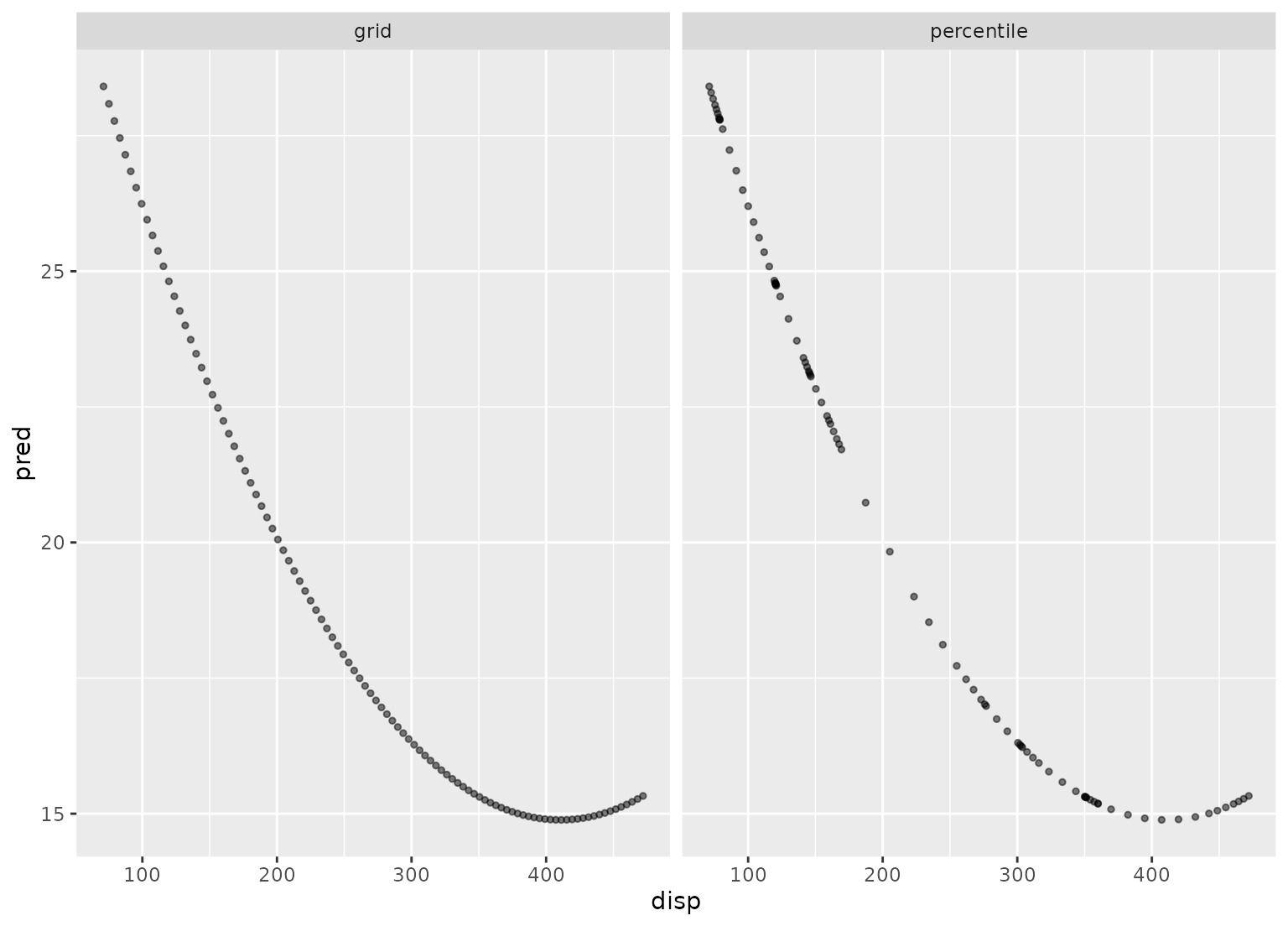step_profile() 创建配方步骤的规范,该步骤将修复除一个变量之外的所有变量的级别,并将为其余变量创建一系列值。在为加法模型创建部分回归图时,此步骤非常有用。
用法
step_profile(
recipe,
...,
profile = NULL,
pct = 0.5,
index = 1,
grid = list(pctl = TRUE, len = 100),
columns = NULL,
role = NA,
trained = FALSE,
skip = FALSE,
id = rand_id("profile")
)参数
- recipe
-
一个菜谱对象。该步骤将添加到此配方的操作序列中。
- ...
-
一个或多个选择器函数用于为此步骤选择变量。有关更多详细信息,请参阅
selections()。 - profile
-
调用
dplyr::vars())以指定将分析哪个变量(请参阅selections())。如果某个列同时包含在要修复的列表和要分析的列表中,则会引发错误。 - pct
-
0 到 1 之间的值,是固定连续变量的百分位数。这适用于选择器捕获的所有连续变量。对于日期变量,根据与
pct的距离使用最小值、中值或最大值。 - index
-
定性变量的水平将被固定。如果变量是字符(不是因子),则这将是排序的唯一值的索引。这适用于选择器捕获的所有定性变量。
- grid
-
包含元素
pctl(逻辑)和len(整数)的命名列表。如果pctl = TRUE,则len表示用于创建分析网格的百分位数。这将创建一个介于 0 和 1 之间的网格,并且配置文件由数据的百分位数确定。例如,如果pctl = TRUE和len = 3,则配置文件将包含最小值、中值和最大值。如果是pctl = FALSE,它定义应在最小值和最大值之间创建多少个网格点。对于定性变量,该参数将被忽略(因为它们所有可能的水平都已被分析)。对于日期变量,将始终使用pctl = FALSE,因为日期没有分位数方法。 - columns
-
所选变量名称的字符串。该字段是一个占位符,一旦使用
prep()就会被填充。 - role
-
由于没有创建新变量,因此此步骤未使用。
- trained
-
指示预处理数量是否已估计的逻辑。
- skip
-
一个合乎逻辑的。当
bake()烘焙食谱时是否应该跳过此步骤?虽然所有操作都是在prep()运行时烘焙的,但某些操作可能无法对新数据进行(例如处理结果变量)。使用skip = TRUE时应小心,因为它可能会影响后续操作的计算。 - id
-
该步骤特有的字符串,用于标识它。
整理
当您 tidy() 此步骤时,将返回包含列 terms(将受影响的列)和 type(已修复或已分析的列)的 tibble。
例子
data(Sacramento, package = "modeldata")
# Setup a grid across beds but keep the other values fixed
recipe(~ city + price + beds, data = Sacramento) %>%
step_profile(-beds, profile = vars(beds)) %>%
prep(training = Sacramento) %>%
bake(new_data = NULL)
#> # A tibble: 6 × 3
#> city price beds
#> <fct> <int> <int>
#> 1 ANTELOPE 220000 1
#> 2 ANTELOPE 220000 2
#> 3 ANTELOPE 220000 3
#> 4 ANTELOPE 220000 4
#> 5 ANTELOPE 220000 5
#> 6 ANTELOPE 220000 8
##########
# An *additive* model; not for use when there are interactions or
# other functional relationships between predictors
lin_mod <- lm(mpg ~ poly(disp, 2) + cyl + hp, data = mtcars)
# Show the difference in the two grid creation methods
disp_pctl <- recipe(~ disp + cyl + hp, data = mtcars) %>%
step_profile(-disp, profile = vars(disp)) %>%
prep(training = mtcars)
disp_grid <- recipe(~ disp + cyl + hp, data = mtcars) %>%
step_profile(
-disp,
profile = vars(disp),
grid = list(pctl = FALSE, len = 100)
) %>%
prep(training = mtcars)
grid_data <- bake(disp_grid, new_data = NULL)
grid_data <- grid_data %>%
mutate(
pred = predict(lin_mod, grid_data),
method = "grid"
)
pctl_data <- bake(disp_pctl, new_data = NULL)
pctl_data <- pctl_data %>%
mutate(
pred = predict(lin_mod, pctl_data),
method = "percentile"
)
plot_data <- bind_rows(grid_data, pctl_data)
library(ggplot2)
ggplot(plot_data, aes(x = disp, y = pred)) +
geom_point(alpha = .5, cex = 1) +
facet_wrap(~method)

相关用法
- R recipes step_poly_bernstein 广义伯恩斯坦多项式基
- R recipes step_pls 偏最小二乘特征提取
- R recipes step_pca 主成分分析信号提取
- R recipes step_poly 正交多项式基函数
- R recipes step_percentile 百分位变换
- R recipes step_unknown 将缺失的类别分配给“未知”
- R recipes step_relu 应用(平滑)修正线性变换
- R recipes step_impute_knn 通过 k 最近邻进行插补
- R recipes step_impute_mean 使用平均值估算数值数据
- R recipes step_inverse 逆变换
- R recipes step_ratio 比率变量创建
- R recipes step_geodist 两个地点之间的距离
- R recipes step_nzv 近零方差滤波器
- R recipes step_nnmf 非负矩阵分解信号提取
- R recipes step_normalize 中心和比例数值数据
- R recipes step_depth 数据深度
- R recipes step_other 折叠一些分类级别
- R recipes step_harmonic 添加正弦和余弦项以进行谐波分析
- R recipes step_corr 高相关滤波器
- R recipes step_novel 新因子水平的简单赋值
- R recipes step_select 使用 dplyr 选择变量
- R recipes step_regex 检测正则表达式
- R recipes step_spline_b 基础样条
- R recipes step_window 移动窗口函数
- R recipes step_ica ICA 信号提取
注:本文由纯净天空筛选整理自Max Kuhn等大神的英文原创作品 Create a Profiling Version of a Data Set。非经特殊声明,原始代码版权归原作者所有,本译文未经允许或授权,请勿转载或复制。
